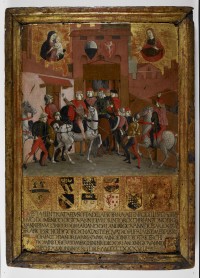 The Spoliation Advisory Panel, a committee of the British Department for Culture, Media & Sport, has issued a report (pdf) recommending that the British Library return a 15th century painted wood panel to the descendants of its 1936 owners. It’s not so much a matter of law — the original owners’ title would have expired by 1948 at the latest and the British Library didn’t take possession of the piece until 1968 — but rather the “moral strength of the Claimants’ case” that underpins the recommendation.
The Spoliation Advisory Panel, a committee of the British Department for Culture, Media & Sport, has issued a report (pdf) recommending that the British Library return a 15th century painted wood panel to the descendants of its 1936 owners. It’s not so much a matter of law — the original owners’ title would have expired by 1948 at the latest and the British Library didn’t take possession of the piece until 1968 — but rather the “moral strength of the Claimants’ case” that underpins the recommendation.
The panel is a tempera on wood painting attributed to Guidoccio Cozzarelli that originally was used to cover ledgers and other financial records in the Biccherna, the Sienese treasury that managed all the city-state’s revenues and expenses. It depicts the entrance and the exit of public officers from the Biccherna in 1488. Underneath the cityscape are the coats of arms of the officials; underneath the coats of arms the officials’ names are listed.
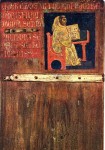 The practice of covering the records of the Biccherna with painted panels began in the mid-13th century. They started off as simple designs — the camerlengo (the chamberlain or head treasury official) at his desk, the coats of arms of Biccherna officials — and became increasingly complex as the city grew in wealth and political prominence. They began to include historical scenes, current events and religious allegories, eventually growing beyond the constraints of the ledger cover into wood panel paintings commissioned from the area’s best artists that were hung on the treasury wall.
The practice of covering the records of the Biccherna with painted panels began in the mid-13th century. They started off as simple designs — the camerlengo (the chamberlain or head treasury official) at his desk, the coats of arms of Biccherna officials — and became increasingly complex as the city grew in wealth and political prominence. They began to include historical scenes, current events and religious allegories, eventually growing beyond the constraints of the ledger cover into wood panel paintings commissioned from the area’s best artists that were hung on the treasury wall.
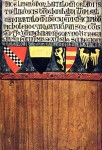 Although much of the vigour of the form was lost after Cosimo de’ Medici conquered Siena in 1555, Biccherne continued to be made into the 17th century. They began to be dispersed in the 18th century when local families claimed them as testaments to their lines’ histories and heraldry. The city’s archive of panels was plundered by Napoleon and shipped to Paris. They were sent back after the Bourbon Restoration (one cartload fell into the Rhône on the way), but some of them were sold off when they arrived. The city’s collection was gradually pieced back together starting in the 19th century. Today there are 105 Biccherne on display at the Siena State Archives.
Although much of the vigour of the form was lost after Cosimo de’ Medici conquered Siena in 1555, Biccherne continued to be made into the 17th century. They began to be dispersed in the 18th century when local families claimed them as testaments to their lines’ histories and heraldry. The city’s archive of panels was plundered by Napoleon and shipped to Paris. They were sent back after the Bourbon Restoration (one cartload fell into the Rhône on the way), but some of them were sold off when they arrived. The city’s collection was gradually pieced back together starting in the 19th century. Today there are 105 Biccherne on display at the Siena State Archives.
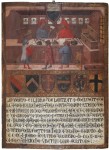 The Biccherna panel now in the British Library was in a Jewish-owned Munich art gallery whose contents were forcibly sold at auction in June of 1936. The owners had been presented with an extortionate tax bill in 1935, a common Nazi practice which, coupled with banking restrictions and other fees and tariffs, ensured Jews would be stripped of all their property before they could leave the country. When, as expected, they couldn’t pay the bill, they were forced to sell their assets at absurdly low prices. In 1930 the Biccherna panel was priced at 15,000 Reichsmarks (about $3,500 dollars in 1930 because inflation in Germany was crazy; at 1936 rates it was worth nearly double). At the 1936 auction it sold for 2,800 Reichsmarks, the equivalent of about $1,100 at the more stable currency conversion rate.
The Biccherna panel now in the British Library was in a Jewish-owned Munich art gallery whose contents were forcibly sold at auction in June of 1936. The owners had been presented with an extortionate tax bill in 1935, a common Nazi practice which, coupled with banking restrictions and other fees and tariffs, ensured Jews would be stripped of all their property before they could leave the country. When, as expected, they couldn’t pay the bill, they were forced to sell their assets at absurdly low prices. In 1930 the Biccherna panel was priced at 15,000 Reichsmarks (about $3,500 dollars in 1930 because inflation in Germany was crazy; at 1936 rates it was worth nearly double). At the 1936 auction it sold for 2,800 Reichsmarks, the equivalent of about $1,100 at the more stable currency conversion rate.
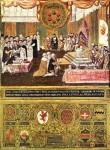 There is no record of who bought it at the forced sale. The panel next appears at a Sotheby’s auction in London in 1942. It was sold as part of the collection of Arthur Bendir and was purchased by Henry Davis, a collector of important book bindings. Davis donated it to the British Library in 1968 as part of a gift of 890 rare bindings. Its place in the Henry Davis Gift is one of the reasons the BL really wants to keep the panel. It wants to keep the collection intact and accessible to scholars.
There is no record of who bought it at the forced sale. The panel next appears at a Sotheby’s auction in London in 1942. It was sold as part of the collection of Arthur Bendir and was purchased by Henry Davis, a collector of important book bindings. Davis donated it to the British Library in 1968 as part of a gift of 890 rare bindings. Its place in the Henry Davis Gift is one of the reasons the BL really wants to keep the panel. It wants to keep the collection intact and accessible to scholars.
The claimants submitted their case to the Spoliation Advisory Panel because the BL can only return an object of cultural heritage in its collection at the recommendation of the Panel and with the approval of Culture Minister. They want the Biccherna Panel back. The British Library hopes to negotiate payment in lieu of restitution. The Spoilation Panel is fine with that plan, but it’s the claimants that will make the final call. If they can’t agree to a compensation solution, then the BL will have to return the piece.